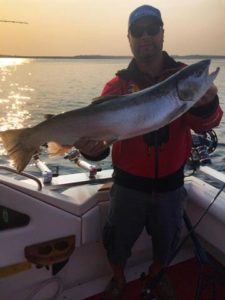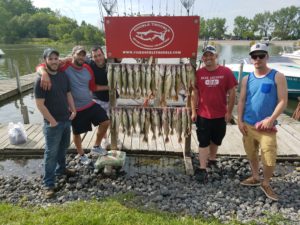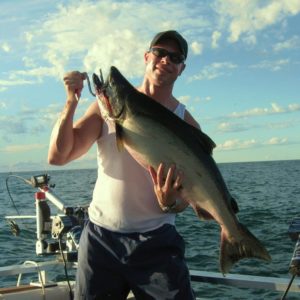Ever since the salmon were first planted in the Great Lakes in the late 1960’s, anglers have been evolving their techniques with each passing season. From the simple but effective J-Plugs to the sophisticated E-Chip, which sends an electronic pulse through the water to attract fish, lures have advanced drastically throughout the years. There are lures that glow, flash, shine, and everything in between. Lure makers seem to focus their attention on the salmon’s vision and ability to sense vibration. Although many of the products on the market today are very effective, they fail to utilize a king salmon’s most keen sense: their sense of smell. It has been said that a salmon’s sense of smell can distinguish between merely a few parts per million. In laymen’s terms, a salmon can find a needle in a haystack simply with its nose! Just think how much more effective your presentation will be when you add a little bit of meat to your spread.
Salmon anglers from across North America have used herring rigs for years; from the salt waters of the Pacific to the fresh waters of Lake Ontario, these lures have been used to great success in nearly all situations. Because of that triumph, anglers in Lake Michigan began to experiment with them in recent years and found out just how deadly they can be. And the reason is simple: these lures not only look and sound like a wounded baitfish, but they smell like one too!
Despite the success of fishing with herring, many fishermen are reluctant to even attempt fishing with it. Whether they are unsure of the effectiveness or simply don’t want to invest more money into their seemingly endless tackle supply, many seem to shy away from this type of fishing. But the truth is that fishing with meat rigs is effortless and you need not change your entire fishing presentation to adapt. I have found that you only need one or two in the water at a time to be successful; using more than that seems to put too much pressure on the fish, and will likely cause you to have fewer strikes. The remaining rods throughout my spread have traditional lures such as plugs, spoons, and rotators with flies. But on a normal day my two rods with meat rigs will produce more fish during daylight hours than my remaining eight rods combined, without a doubt. It is easy to see why this method has become so popular in recent years.
Before wetting a line, you must first select the type of meat rigs that you will be using. If you are not familiar with them, a meat rig is very similar to a flasher with a fly, except rather than a fly a strip of herring is used. Through several attempts of trial and error, I discovered that meat rigs work best when used with very large rotators that provide the most possible flash and action. The rigs that I have had the most success with over recent years are the 10 and 13 inch models made by Capt. John King from Manistee. I have tried many other types and combinations throughout the years and nothing else seems to compare.
Once you have the rigs you must then choose the bait that is to be used. I have had the best luck with herring strips, which is simply a single fillet of herring. Many fishermen use the whole herring, but I find it easier to use the strips because they are all identical in size and much easier to work with.
After you have the rigs and the bait, it is time to go fishing. During periods of dawn and dusk, I normally don’t even put meat rigs in the water because they are typically not necessary. In low light conditions salmon are usually aggressively feeding and will strike anything in the water, meat rigs are much more effective when fished during the day when fishing is generally much slower. Once the fish have become more sluggish after sunrise, take one of your meat rigs and put it on a downrigger. If you are using the King Flashers mentioned earlier, be sure to run them no more than 15’ behind your cannonball. If you run them too far behind they will cause many unwanted tangle problems. They seem to work best when they are fished deeper than the rest of the lures in your spread. Typically I start them anywhere from 60 to 90 feet down and lower them as it gets later in the day. Don’t be afraid to go very deep, sometimes they are most effective 150-200 feet down, even late in the season. Many anglers don’t ever think of fishing that deep because they believe that only Lake Trout are that low in the water column, but during the periods of high sun the deep water is loaded with kings. When fishing very deep, I like to use the meat rigs that come equipped with glow tape on them because even on the sunniest of days it going to be very dark at great depths.
If you find that you would like to put another meat rig in the water, they also seem to be very efficient on dipsy divers as well. Just like the downriggers they work best when they are deep. After the morning flurry of action, put a meat rig behind a dipsy diver and run it a long distance behind the boat. I have taken fish as far as 250’ back so don’t be afraid of going too deep, especially if the water is warm. Be careful not to make your leaders between the dipsy and the meat rig too long if they because it will make netting fish incredibly difficult. Other than that they are no different than fishing with any other type of lure.
If you have never tried meat rigs before you are missing out on an amazing fish catching tool for Great Lakes Salmon. Putting herring in the water is like waving a chocolate chip cookie in front of a child, they simply can’t resist. Next time you head out on to the water, give them something they can smell and you will experience just how lethal this technique can be.



